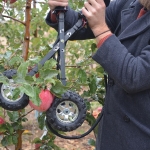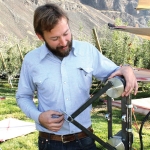He knew it had been tried before. His literature searches showed that back in the 1950s and 1960s, the industry was voicing the same fears as today about shortages of harvest labor. In fact, the Washington Tree Fruit Research Commission was founded in 1969 with the primary goal of pursuing mechanical harvesting.
Today, fully mechanized apple harvesting is still a dream. Although a number of machines have been developed in recent years to assist harvest workers and improve efficiency, orchardists still depend on a human being to pick apples off the trees.
Efforts to develop a robotic “end effector” (the gadget that actually picks the apple) have so far been fruitless, but De Kleine thinks there could be mechanical ways to get the apples off the trees more quickly than a human can pick them. For his Ph.D. project, he’s developing three different apple removal methods that might eventually work in tandem with the high-tech fruit transportation systems that have already been developed.
“There are systems out there right now that are working on taking the apple from the picker to the bin,” he said, citing the DBR, Picker Technologies, and Van Doren/Littau harvest-assist systems. “But it starts with the human.
“I’m not trying to reinvent the wheel,” he emphasized. “I’m trying to take pieces and fit them together in a system that works. Ultimately, it comes down to economics.”
He calculates that 14 billion apples are harvested in Washington each year for the fresh market. A worker can pick an apple per second. Previous research with robotic harvesters showed it could take eight or more seconds for a robot to locate an apple, grab it, and bring it to the bag, he said.
“Ten seconds times 14 billion–that’s a lot of seconds,” he said. “Are there that many seconds in an eight-week harvest window?”
Better way
Although De Kleine hadn’t thought specifically about apple harvesting before applying to WSU, he recalls picking cherries on his family’s farm at Grand Haven, Michigan, and thinking, ‘There has to be a better way to do this!’ and asking himself ‘Is there some machine I can create to make this a little bit easier for me or someone else?'”
His fascination with machines goes back much further. He was nine years old when someone at his church made him an offer he couldn’t refuse: “I will sell you a snow blower for $5, but it doesn’t work,” the man told him.
His father, Carl, a farmer with an agricultural engineering degree, helped him get the blower running and that winter De Kleine started a business blowing snow for the neighbors.
“I came back and I had a wad of cash, and I’m nine years old,” he recalled. “My parents are thinking, that’s a lot of baseball cards!”
The following summer, the neighbor across the street paid him $5 to mow his lawn, which led to a thriving and prosperous lawn-mowing business that De Kleine continued through college. Starting as a youngster, De Kleine enhanced his business by taking soil samples from his clients’ yards to the Michigan State University extension office for nutrient analysis so he could advise on fertilizer applications.
After earning a bachelor’s degree in biosystems engineering at MSU, with an emphasis on power and machinery, he got a job at Caterpillar designing hydraulic systems for motor graders. He liked the job but decided to go back to MSU to earn a master’s degree. For his master’s project, he developed a chestnut harvesting system that separated the nuts from the burrs and orchard trash. It was a fun project that convinced him his future was in agricultural research.
Then he saw an announcement from WSU’s Center for Precision Agriculture and Automated Systems about an opening for a Ph.D student in mechatronics. He knew that Washington was a big player in specialty crop agriculture and felt sure that precision agriculture represented the future of the industry.
“I could not have written a better description of what I wanted to do,” he said.
Now starting his third academic year at WSU, De Kleine has finished his coursework for his doctorate and plans to graduate in the spring of 2014. For his dissertation, he is testing three harvesting techniques that are at the proof-of-concept stage.
He’s taken a practical approach. “There may be a million-dollar machine to do something, but if it’s not in every single field, I think it’s not a solution,” he said. “Economics would say you have to have a certain number of acres to make it affordable, so anyone who has less than that doesn’t get the benefit of the solution.”
That’s why he’s focusing on improving what a human can do.
He started by studying how apples are picked by hand and noticed that a worker twists the apple to detach the stem from the tree. He set about building a handheld device to mimic that twist, using off-the-shelf parts including parts of drills and rubber wheels from a remote-control car. When placed around an apple, the wheels can be moved either clockwise or counterclockwise and at different speeds to twist the fruit. It’s designed to be used with trellised trees forming a fruiting wall, where the fruit are stable and accessible. He is doing experiments to see if the apples fall with or without stems and if there’s the risk of removing spurs along with the fruit. De Kleine envisions that, in a commercial setting, the device would need more wheels or even rotating cylinders to allow workers to pick multiple fruit at a time.
He’s also doing experiments with a Milwaukee Sawzall, which graduate students at the Center for Precision Agriculture have adapted for cherry harvesting by fitting it with an end effector that can shake a trunk or limb with an in-and-out motion of 3,200 strokes per minute. De Kleine is looking at the potential for using this tool to harvest apples.
Another device he developed is also designed to shake the trunk or branch of a tree to remove the fruit. The end effector, which fits around the trunk or branch, consists of a dual motor actuator, which has two eccentrics that can rotate in either clockwise or counterclockwise directions and at different speeds. This allows the user to strategically create, and apply, an infinite number of rhythmic patterned movements, rather than being limited to a back-and-forth motion.
All these methods would require catch frames to collect the fruit. He is also exploring the use of non-Newtonian, shear-thickening fluid surfaces that could cushion the apples when they fall in order to minimize bruising. Last year, he demonstrated the concept for STEM (Science, Technology, Engineering, Mathematics) students by using a surface of cornstarch and water that thickens temporarily with the force of a falling apple.
De Kleine, 33, hopes to keep working in agriculture and academics after he completes his doctorate and wants to get a harvesting solution into the hands of growers.
“Agriculture isn’t a fad,” he said. “It’s something that’s always been here. It’s my passion. It’s a privilege for me to be out here contributing and helping as much as I can.” •
De Kleine received WSU’s William R. Wiley Research Exposition award this year in the Agricultural and Natural Sciences poster category. The award recognizes students for exemplary scholarship and research.









Leave A Comment